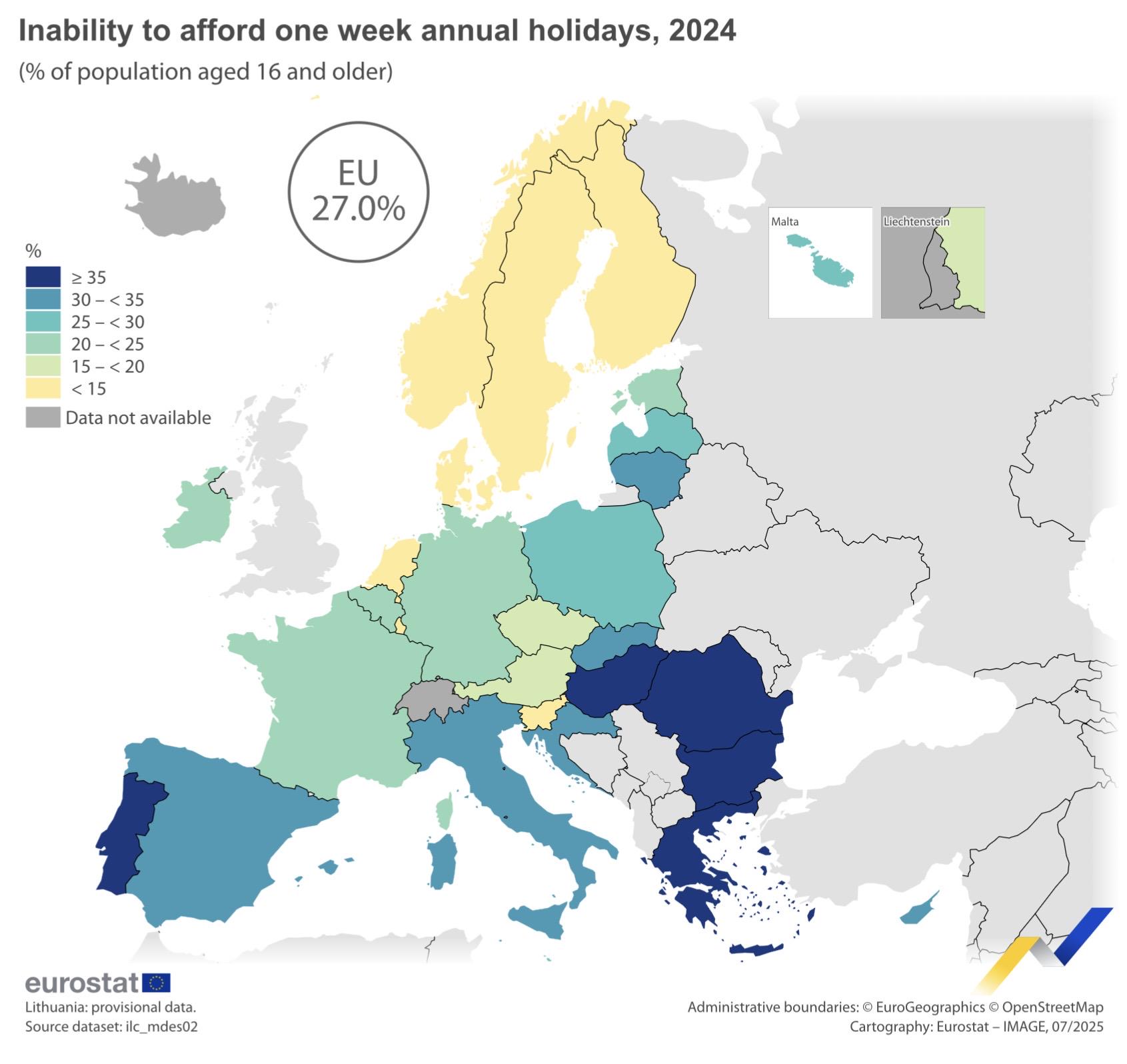Map of Europeans Unable to Afford Holiday


Alex Cartwright
Senior Cartographer & GIS Specialist
Alex Cartwright is a renowned cartographer and geographic information systems specialist with over 15 years of experience in spatial analysis and data...
Geographic Analysis
What This Map Shows
The map titled "27% of Europeans could not afford a week-long holiday" visually represents the percentage of the population in various European countries that struggle to finance a vacation of this duration. With the rising cost of living in many parts of Europe, this map highlights the economic strain faced by a significant portion of the population. Transitioning from this visualization, the topic of economic disparity and access to leisure activities in Europe becomes crucial to explore.
Deep Dive into Economic Disparity in Europe
Economic disparity in Europe is a multifaceted issue, often influenced by factors such as income levels, employment opportunities, and social safety nets. With 27% of Europeans unable to afford a week-long holiday, this figure raises questions about the broader economic landscape. The European Union has long prioritized economic cohesion, yet stark contrasts in income and living standards persist across member states.
Interestingly, countries in Southern Europe often report higher percentages of individuals unable to take holidays compared to their Northern counterparts. For instance, nations like Greece and Portugal face economic challenges that have been exacerbated by recent financial crises, with unemployment rates still higher than the EU average. In contrast, countries such as Germany and the Netherlands showcase lower percentages of holiday inaccessibility, thanks to more robust economies and social welfare systems.
Moreover, the ability to afford leisure activities isn’t solely based on income. It’s also about how disposable income is allocated. In many households, essential expenses such as housing, food, and healthcare consume the majority of income, leaving little room for leisure spending. A report from Eurostat indicates that in some of the most affected countries, as much as 80% of household income goes towards these basic needs.
Furthermore, the COVID-19 pandemic has had a lasting impact on people’s finances. The uncertainty created by lockdowns and job losses has led many to prioritize savings over spending on holidays. In fact, some surveys indicate that even as restrictions ease, many Europeans remain hesitant to spend on vacations, fearing potential future economic instability. This shift in mindset is notable and could have long-term implications for the tourism industry across Europe, which relies heavily on both domestic and international travelers.
Regional Analysis
As we delve deeper into the regional analysis, it’s important to highlight some of the stark differences across Europe. In Northern Europe, particularly Scandinavian countries, the ability to afford a holiday is relatively high. Nations like Norway and Sweden have robust economies, high standards of living, and extensive social safety nets that help residents enjoy leisure time without the associated financial stress. Interestingly, these countries often have a strong emphasis on work-life balance, encouraging their citizens to take time off to recharge.
On the other hand, Southern European countries often see higher percentages of individuals unable to afford a holiday. In Spain, for example, an estimated 30% of the population struggles with this issue, particularly among younger people and families. Economic recovery has been slow in regions affected by tourism downturns, and many households remain cautious about spending on non-essential activities.
Eastern Europe presents a mixed picture. Countries like Poland have seen significant economic growth and rising incomes, yet challenges remain. For instance, while urban areas may afford more leisure activities, rural populations often experience higher rates of economic hardship, limiting their ability to travel. In contrast, countries like Romania and Bulgaria report some of the highest percentages of individuals unable to afford vacations, reflecting lingering economic challenges in the region.
Significance and Impact
Understanding the implications of this map is crucial. The inability to afford a holiday is not just a matter of personal choice; it reflects broader societal issues, including economic inequality, access to resources, and overall quality of life. Holidays are essential for mental health and well-being, allowing individuals to disconnect from work and recharge. When a significant portion of the population cannot access this basic leisure activity, it raises concerns about the quality of life in those regions.
Moreover, the impact extends beyond individual households. The tourism industry, a vital component of many European economies, thrives on consumer spending. If a significant number of people cannot afford vacations, it could lead to decreased revenue for businesses reliant on tourism. This decrease could, in turn, create a cycle of economic decline, affecting employment rates and overall economic stability.
Looking ahead, it will be interesting to see how trends evolve. With the increasing cost of living and economic uncertainty, the proportion of Europeans unable to afford holidays may rise. Alternatively, as economies recover from the pandemic, we might witness a shift towards increased spending on leisure, particularly if governments take steps to bolster economic support for vulnerable populations.
In conclusion, the map serves as a poignant reminder of the economic realities faced by many Europeans today. As we continue to monitor these trends, it’s essential to advocate for policies that promote economic equality and accessibility to leisure activities for all.
Comments
Loading comments...